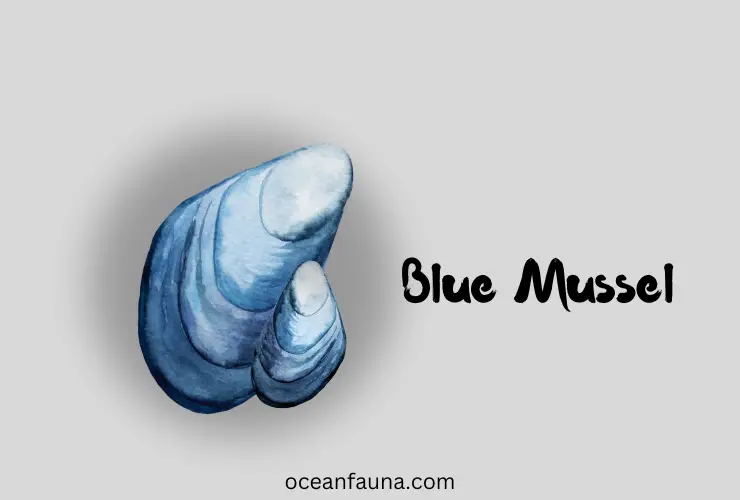Blue mussels are a type of shellfish living in oceans worldwide. They are recognizable by their rigid, bluish-black oval shells that can grow up to 10 cm long.
They use their sturdy threads to attach themselves to objects. They are a delicacy in many parts of the world and are often used in seafood dishes such as paella and chowder.
But blue mussels are more than just a tasty treat. They play a vital role in filtering our oceans and keeping them healthy. As filter feeders, blue mussels filter the water they live in, removing harmful pollutants and excess nutrients from the ocean.
This process helps maintain water quality and benefits other marine life that relies on the ocean as a food source. It even benefits humans dependent on the ocean for food and recreation. In this blog, we’ll take a closer look at the biology and ecology of blue mussels.
About Blue Mussels – A Quick Biology
Let’s take a quick look at this fish species.
| Parameters | Details |
| Scientific name | Mytilus edulis |
| Kingdom | Animalia |
| Family | Mytilidae |
| Genus | Mytilus |
| Phylum | Mollusca |
| Class | Bivalvia |
| Order | Mytilida |
| Species | M. edulis |
| Habitat | Brackish water, Coastal, Estuaries, Intertidal zone, Marine |
| Life Span | 18-24 years |
| Diet | Bacteria, algae, detritus, zooplankton, and phytoplankton |
| Geography | North America, Europe, Alaska, England, Canada, North Carolina |
| Other names | Edible mussel or common mussel |
Geographic Distribution of Blue Mussel
According to the FAO, blue mussels are found in the northern Atlantic Ocean near the coast. They live in North America, the northern Palearctic, and Europe. They live in many areas, such as Russia’s White Sea and southern France.
The blue mussel is also found in the southern Canadian Maritime regions and North Carolina in the western Atlantic. They are also commonly found in the British Isles, with extensive commercial beds in regions like the
- Wash
- Morecambe Bay
- Conway Bay
- Southwest England
- North Wales
- West Scotland.
Habitat and Range of Blue Mussels
According to DFO, blue mussels are adaptable creatures living in various environments. They live both in the ocean and in areas where water meets land. They prefer cold to moderate waters up to a depth of 15 meters.
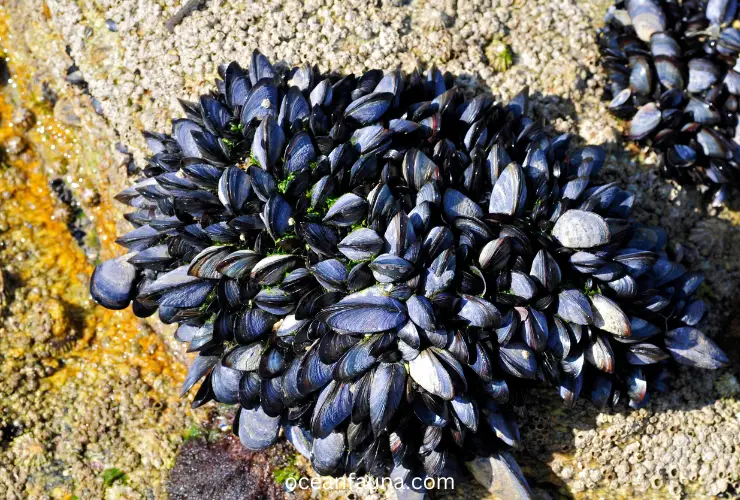
They can be found in estuaries, rocks and seagrass beds. They typically inhabit areas with high nutrient levels from runoff, which causes an increase in phytoplankton.
Appearance of Blue Mussels
Research says, the blue mussel has a dark blue or purple shell that is elongated and slightly curved. They grow up to 2–20 cm long and 1.4–6.5 g in weight.
The mussel’s shell is smooth and shiny, with pointy ends joined together by a hinge. It has curved lines that go around it like rings. The shell is also ribbed, which helps it stay attached to rocks or other surfaces in the water.
The inside of the mussel’s shell is lined with a pearly white material called nacre. This material protects the mussel’s soft body from the rough shell surface. The nacre also gives the shell’s inside a beautiful iridescent sheen.
The blue mussel’s body is smooth and fleshy and usually has a pale beige color. The mussel has two siphons – long tubes that filter water for food and oxygen. When submerged in water, the siphons can be seen poking out of the mussel’s shell. They have tiny byssal threads placed radially from a central stem.
Behavioral Adaptations of Blue Mussels
Mussels are amazing creatures that filter their food out of the water they live in. Even though they don’t have eyes to locate their food, they have a unique structure called an inhalant aperture. According to the Marine Ecology Progress Series, this helps them filter tiny microscopic organisms.
After filtering, they expel water, non-digestible materials, and fecal matter into the ecosystem through the exhalant siphon aperture.
Mussels also have a protective shell that shields them from the sun’s harmful rays during low tide. This helps them preserve their water storage and avoid dehydration.
Mussels use a proteinaceous thread called the byssus to attach themselves to solid underwater surfaces. The byssus is critical for mussels’ ecology, physiology, and evolution. As mussels cluster together to form mussel beds, they create habitats for other creatures.
These bunched mussels actively filter feed for nutrients. They also consume contaminants and suspended particles, making them ideal for pollution studies, particularly microplastic pollution.
Interestingly, the Byssus also allows mussels to attach themselves to artificial structures, such as quay walls and power plant channels. These structures are less attractive to native species, and mussels can hitchhike on ships, which facilitates their invasiveness.
Feeding/Diet – Are Blue Mussels Omnivorous or Carnivorous?
Blue mussels are naturally omnivores and consume a variety of marine and free-floating creatures, such as bacteria, algae, detritus, zooplankton, and phytoplankton.
These foods include green algae, cyanobacteria, dinoflagellates, coccolithophores, and diatoms. Blue mussels are filter feeders and obtain their food by filtering seawater through their gills.
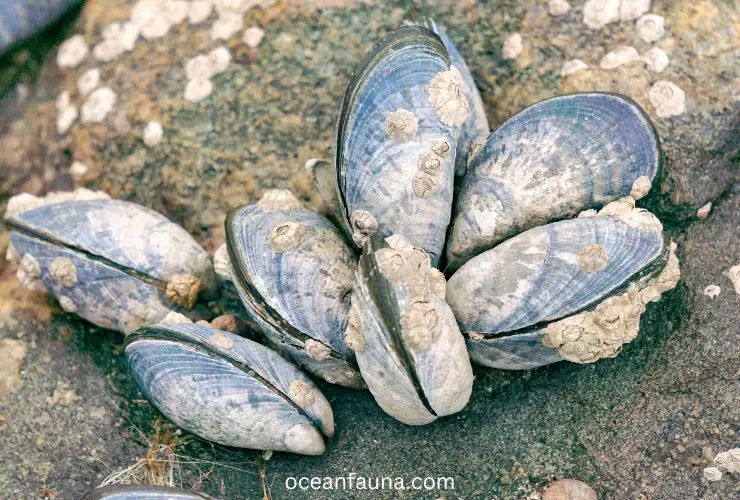
Reproduction and Early Development of Blue Mussels
Blue Mussels can be male or female (dioecious), but sometimes they have both sexes (hermaphrodites). They become ready to mate in late spring or early summer and make eggs or sperm in their mantle, a part of their body.
They usually breed between May and August, influenced by food levels, temperature, and physical disturbances in the water. After mating, they release eggs or sperm into the water, and you can see a whitish or orange cloud. Eggs and sperm join together and form tiny swimming creatures called larvae.
Also Read: Teredo Navalis: Habitat, Diet, Anatomy, And Other Facts
The larvae are free-swimming and consume small plants in the water for 3–4 weeks. Then, they undergo a significant change called metamorphosis. It is where they start looking for a place to attach themselves, like rocks or other things underwater. This usually happens between mid-June and late July and is called a mussel spatfall.
Young mussels can move around with their feet or float in the water. They keep changing locations until they find a suitable place to grow into adult mussels.
Predators (Who eats Blue Mussel?)
Blue mussels have various natural predators, including birds and sea stars. Gulls, ducks, geese, and other aquatic birds eat blue mussels. These birds often dive under the water to grab buried mussels and use their powerful beaks to crack them open.
Sea stars or starfish also consume mussels, using their many “arms” to scoop them out from under the sand and swallow them whole.
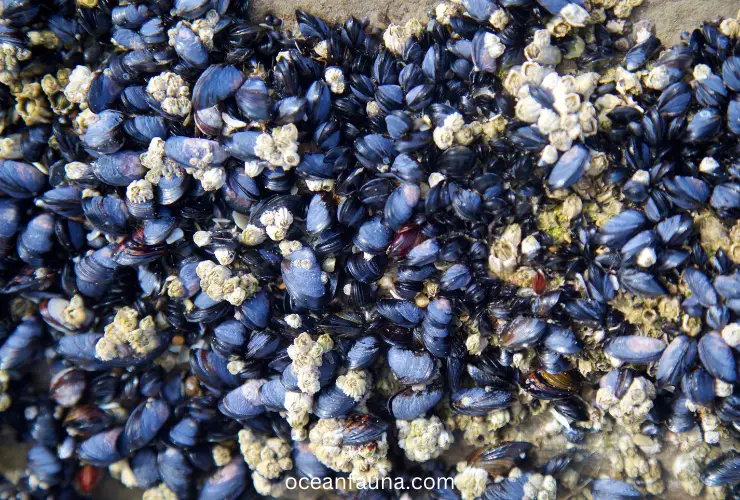
Human Uses
Blue mussels are a type of edible marine bivalve mollusk used by humans for various purposes for thousands of years. Early Americans harvested freshwater mussels for food and used their shells to temper pottery and create tools, utensils, and jewelry. Today, blue mussels are commercially harvested and used in aquaculture.
They also have various health benefits, such as protecting the gastrointestinal tract, treating sports-related injuries, boosting immunity, and aiding in healthy nerve cell functioning.
Population of Blue Mussels
Unfortunately, the blue mussel population has declined recently. Ecologists at the University of California, Irvine, have reported that the Gulf of Maine’s blue mussel population is disappearing in the intertidal zone. The population has declined by more than 60% over the past 40 years.
How Do Blue Mussels Protect Themselves?
Blue mussels protect themselves through a variety of mechanisms, both physical and behavioral. Here are some ways they protect themselves:
- Shell: Like most mollusks, blue mussels have a rigid, protective shell that shields them from predators and environmental stresses.
- Byssal threads: Blue mussels have byssal threads. These are strong, adhesive fibers that help them attach to rocks or other rigid substrates. This helps them avoid being dislodged by waves or predators.
- Closing their shells: When threatened, blue mussels close their shells tightly, making it harder for predators to reach their soft body tissues.
- Reducing water intake: Blue mussels can also minimize water intake through their siphons when they sense predators nearby. This helps them avoid harmful substances or predators.
- Camouflage: Blue mussels can blend in with their surroundings by changing the color of their shells to match the substrate they are attached to, making them less visible to predators.
- Reproduction: Blue mussels reproduce rapidly. It allows them to recolonize areas depleted by predation or other disturbances quickly.
Can You Eat Blue Mussel?
Blue mussels are edible and considered a wise seafood choice. That is because they are raised and harvested sustainably according to regulations set by the U.S. government.
Blue mussels are popular among fishermen for their rich, sweet flavor. They can be eaten raw, steamed, boiled, fried, or in seafood pasta or cioppino dishes.
In terms of nutritional content, blue mussels are a highly nutritious source of protein and have an impressive nutritional profile. A three-ounce portion of cooked blue mussels comprises
- Twenty grams of protein (40% of the recommended daily dose).
- 146 calories
- Only a tiny amount of fat.
Blue mussels also contain Omega-3, which is highly beneficial for brain development and nerve cell functioning.
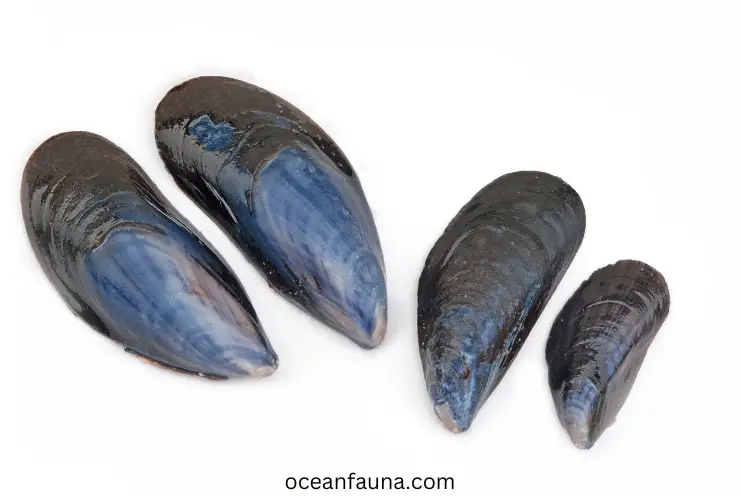
FAQs
Is Blue Mussel Dangerous?
Blue mussels are not dangerous for humans. In fact, they are a popular food source in many parts of the world and are considered safe to eat when harvested from clean waters.
However, be cautious and only consume mussels that have been appropriately cooked. It reduces the risk of foodborne illness caused by bacteria or viruses in raw mussels.
Additionally, mussels can accumulate toxins from harmful algal blooms, so it is important only to consume shellfish that have been tested and deemed safe by regulatory agencies.
What Are Blue Mussel Shells Made of?
Blue mussel shells are made primarily of calcium carbonate, a chemical compound also found in other shells and rocks like limestone and chalk.
The shell comprises a series of interconnected layers, each containing tiny calcium carbonate crystals. The outermost layer of the shell, called the periostracum, is made up of a protein matrix that protects the shell from damage and erosion.
Are Blue Mussels Threatened or Endangered?
Blue mussels are not listed as threatened or endangered under the ‘Endangered Species Act (ESA).’ They are a commercially harvested species abundant in many areas of their range. However, localized declines can occur due to pollution or other factors.
However, it is essential to manage their harvesting sustainably to ensure their continued health and abundance in the wild.
Can Blue Mussels Experience Pain?
No, the nervous system of blue mussels is not centralized. This means it does not have a brain or a centralized location to connect nerve impulses. Therefore, they cannot experience pain.
Conclusion
Blue mussels play a vital role in our oceans. They are filter feeders. This will indicate that they aid in cleaning seawater and improving its quality. They benefit marine life and those who love swimming and fishing since they make the water safer.
Apart from their ecological importance, blue mussels are also a valuable food source worldwide. They contain essential nutrients, making them a healthy and sustainable seafood option.
What’s even more fascinating is that blue mussels are incredibly resilient creatures that can withstand changes in temperature, salinity, and other stressors. This makes them a useful means for environmental monitoring.
They are often used as indicators of ecological health in studies examining the impact of human activities on our oceans.

